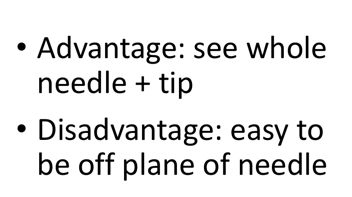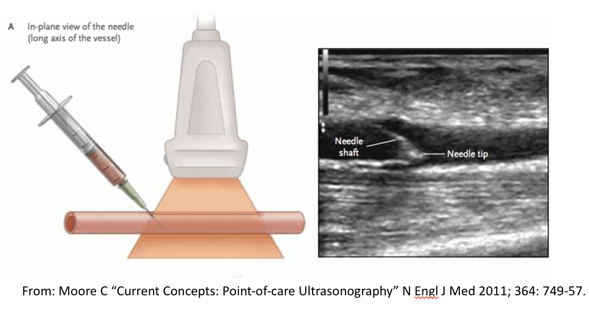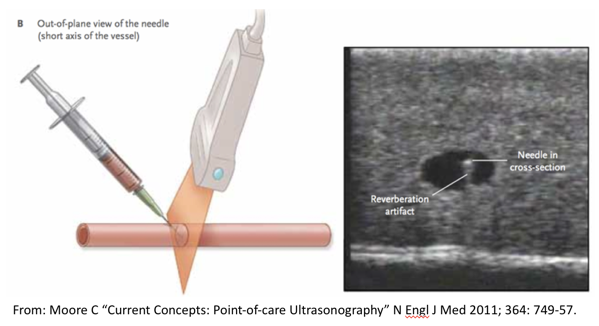In and Out of Plane
“In-Plane”


Narration
So once you've selected the linear probe and visualized the structure you want to access, it's important to understand how the ultrasound plane relates to both the structure you're visualizing and the needle. The terminology we prefer is in-plane versus out-of-plane. Sometimes you hear long axis, short access, but long axis really should be the relationship of the needle to the vessel - which in access procedures are always going to be long axis, whereas in-plane refers to the relationship of the needle to the plane of the ultrasound. So in this case we are seeing the needle enter the vessel and we can see the entire shaft and tip of the needle. This is in the plane of the ultrasound and the advantage is that when done correctly, you can see the entire needle including the tip. The disadvantage is that sometimes it can be tough to tell exactly where you are if you're not in line with the structure.
In Plane Visualization
Narration
So here we see that needle and tip coming in and dynamic in-plane visualization and a vascular access phantom; we're flushing it with some bubbles here and again this works really well as long as everything is in the right place.
Problem With “In-Plane”
Narration
The problem is, in real life sometimes the needle isn't lining up where you want it to go. Here we see a vessel and we also see a needle, but the needle is not entering the vessel and it is off to one side or the other, and it can be difficult to determine which way to direct that needle.
“Out-Of-Plane”


Narration
So I often recommend an out-of-plane approach; this is what I use for all my vascular access procedures. The needle is still going in on the long axis of the vessel, but it is out of plane of the ultrasound. You're going to cut across that needle perpendicular to it - the advantage is that you can position the needle directly underneath the middle of the probe and the structure and make sure you're going in to the right place and you can direct it left or right as needed. The disadvantage is that sometimes it can be tough to tell if you're proximal on the shaft of the needle or distal towards the tip. So what we recommend is that you fan distally to see that needle tip disappear.
The “Vanishing Target Sign”

Narration
We call this the vanishing target sign where when you get the needle tip right where you want in the center of the vessel and you fan the probe distally, the plane goes past the end of the needle tip and you see it disappear or vanish. This is called the vanishing target sign, you can see that on the right where you have a target sign - a bright or hyperechoic dot in the center of the vessel that then goes away as you go a little bit further along.